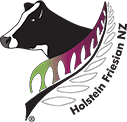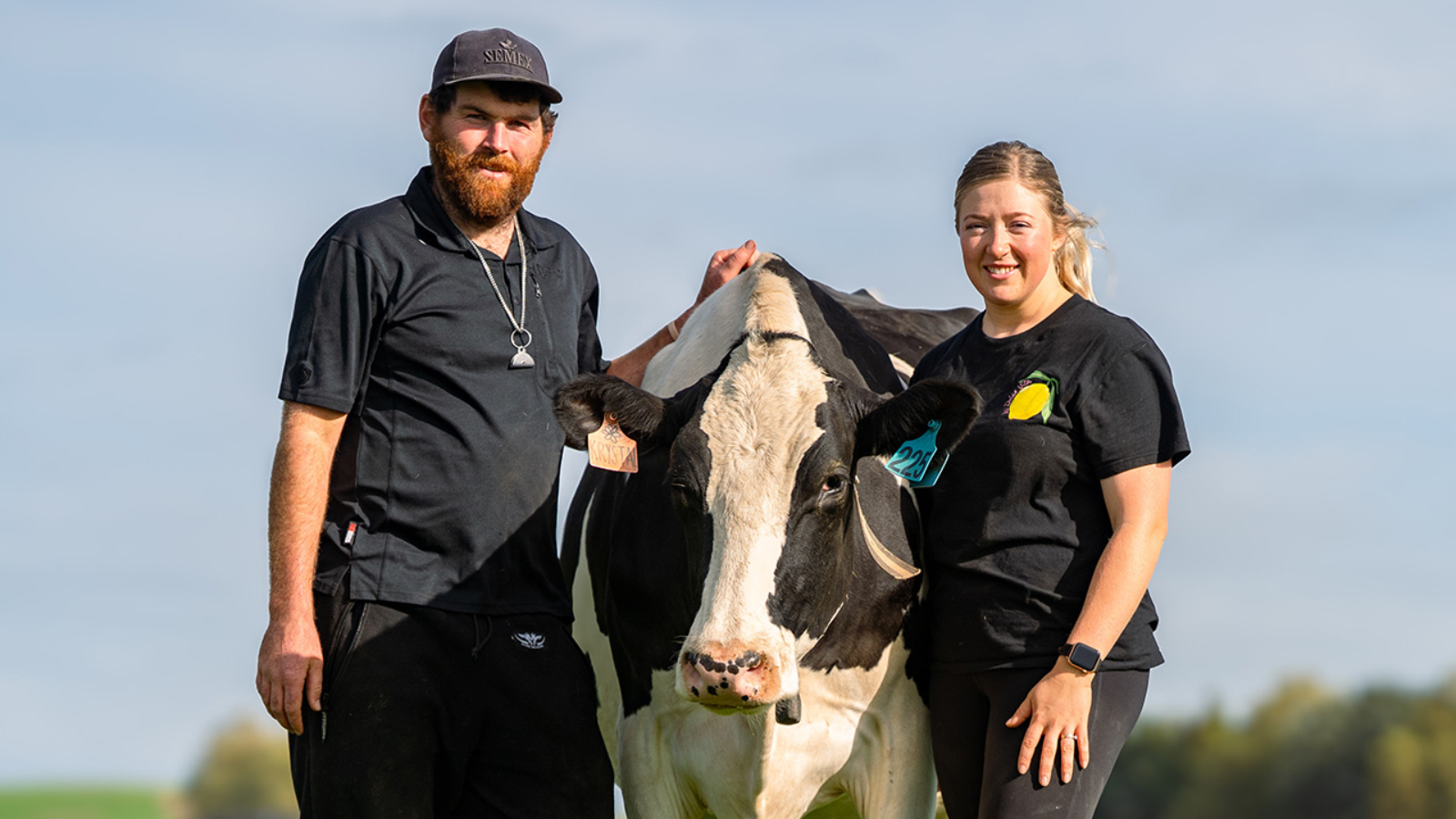Michael Terpstra has achieved a lot in his young life, and he’s not standing still in his quest to run a profitable, high-production herd of Holstein Friesians.
At just 29-years-old, Michael Terpstra has recently ticked off a major life goal—owning his own farm. It was a big leap, but for someone who was contract milking at 21, hard work has never been in short supply.
Neither is it for the 200 high-performing Holstein Friesian cows he and wife Sarah milk, producing a massive 700kgMS per cow.
Having grown up on a family farm in Galatea, Michael had dreams of returning to the area as a farmer himself, after his parents sold the farm when he was 12.
Sarah’s story is similar: her parents were sharemilkers until she was two years old, when the family moved to Australia. They moved back to New Zealand when Sarah was 18.
As a teenager Michael attended Taratahi Agricultural College for one year, then returned to Galatea as he had always wanted.
“It just wasn’t the same,” he says. “I was so gutted when my parents sold the farm.”
After seeing limited possibilities for both career advancement and a social life in Galatea, Michael moved to Palmerston North, where he worked as a 2IC for one year. He then went to a manager’s job in Manawaru, beneath the Te Aroha hills, before moving to Morrinsville to take up another management role, overseeing 250 cows.
“I loved it,” Michael says.
The opportunity arose for Michael to return to the Palmerston North farm as manager on a one-year contract, so he returned to the Manawatu.
His next career step was a contract milking job, which he found in Matamata.
“I was contract milking at 21-years-old,” Michael says proudly.
Two years later he progressed yet again and went sharemilking in Ohaupo.
“I liked the sharemilking, but I really struggled in a challenging working environment,” he says. “For the sake of my mental health I left that job after two years.”
And after three years of a more positive sharemilking position at Kiwitahi, milking 235 cows on 110ha for the Dibble family, Michael decided to let momentum continue to carry him.
“I sometimes found the restrictions of sharemilking challenging, so I bought my own farm in Waihou, where we moved to on June 1,” he says.
The 146ha farm, located between Te Aroha and Morrinsville, has allowed Michael to increase cow numbers to 300 and most importantly, provide him with the freedom to farm the way he wants.
Michael’s father Andre—who has worked alongside him for the past six years—has also made the move, along with Michael’s mother Louise.
“We work well together—we occasionally have a ‘polite disagreement’—but I’m over the moon they are living on farm with us,” he says.
Sarah, a trained vet nurse, has also joined the team full-time after having finished her job in March. They operate on a 2-on, 1-off roster, managing the herd together.
Despite the change of scenery in June, Michael is very happy with the way he runs his business and most of the day-to-day operational strategies have remained the same.
“I try to grow most feed on farm, including maize silage,” he says. “I grow around one tonne of maize per cow on farm, and we grow and harvest 1.5 tonnes of grass silage per cow as well. We also buy in two tonnes of meal per cow.”
Despite the high input system, Michael says he likes to keep things simple.
“I still like to be grass first: as a sharemilker, it’s free, and I just top the cows up with feed,” he says. “I think I’m pretty profitable for a high input farmer; I like making money when it makes money.”
Maize silage is fed from March to September (at around 5-6kg/cow/day) and grass silage from January to March.
The new farm does not have a herd home, a tool used at the previous farm at Kiwitahi, but it does have in-shed feeding capabilities. And, if the payout remains steady, Michael plans to construct a roofed feed pad on the farm in November.
“It helps the cows stay out of the sun and rain and gives them a space where they can be fed properly,” Michael says. “I don’t like paddock feeding at all.”
Having split calved in recent years – six-week calvings, twice a year – Michael has now moved to three-week calvings, three times a year – in July, November and March.
“Three weeks is a nice, quick period, calving 100 cows at a time,” he says.
Mating will be done over 25 days, and any cows that don’t get in calf will be carried through until the next mating period.
“They milk through quite well, and I’ve found that taking them through means they’ll generally hold the next round,” Michael says.
With a sizeable production target, the key trait Michael breeds for is strong udders, as well as capacity to eat the food that is offered to them.
“When you run a high input system, the biggest thing is getting them to eat enough,” Michael says.
“Breeding for rear teat placement and a good rump is good too, but if you try to breed for too many traits, nothing turns out well.”
Sires like Westcoast Alcove and Westcoast Perseus have delivered stand-out progeny in the Hollipork herd.
“The Alcoves have good udders and milk well,” he says. “And the Perseus progeny, which are R4 now, all achieve above-average production and have good type. They hold in calf to sexed semen, and their fertility is really high. They are functional cows that get in calf.”
Michael started building up his own cow families when he was sharemilking at Ohaupo. One cow family, the Krista family, has produced some stand-out progeny.
The original Krista cow, Fantastic Lauth Krista-ET, had three daughters, and her oldest daughter, Hollipork 1stclass Kristy EX, is one of the highest producing cows.
“Her Main Event sister is very good too and was the highest producing cow in the last herd test,” Michael says.
Kristy had a Westcoast Alcove two-year-old last year, Hollipork Alcove Krystal VG87 who, in Michael’s opinion, would make the perfect blueprint for the herd.
“Krystal has a beautiful udder, good capacity and did 750kgMS one year,” he says.
Michael also bought Waipiri Mogul Totie EX five years ago at a sale.
“We’ve got the first two-year-old daughters in the herd now,” he says. “They’re beautiful cows, and one peaked at 2.9 milksolids per day, the highest ever for a heifer in the herd.”
Michael certainly seems to have the hang of breeding on. When he left the management role at Palmerston North, he and the stock agent who sold the herd split a line of 80 heifers, with Michael taking 40 with him.
“They are eight years old now, and we still have half, and have well over 100 daughters and granddaughters in the herd,” he says.
“They were well-put-together cows; without them, I wouldn’t have the herd I do today.”
This season his herd will include 250 Holstein Friesians, and some Jerseys and Ayrshires, while next season, Michael is looking to have around 90% Holstein Friesians and 10% Ayrshires.
“If you feed a Holstein Friesian fully, they are the most profitable cows you can have,” he says. “In my system, Holstein Friesians outperform any other breed when it comes to production per feed.
“I love their will to milk, and their persistence – they just keep going if you keep feeding them. They are the best-uddered cows on my farm.”
Although he’s dipped his toes into the show ring, Michael admits it’s not all glamour.
“It’s a lot of hard work and effort and sometimes the results you didn’t want can come into it, but it’s great to be able to catch up with everyone at the shows,” he says.
Michael and Sarah exhibited some in-milk cows at the Waikato Show in 2024, with five-year-old Fenton Mogul Eleanor EX placing second. “I got Ella for very cheap, and she’s turned out to be one of my nicest cows,” Michael says.
Eleanor had also cleaned up in the Holstein Friesian classes at the 2023 Te Aroha A&P Show, placing first in All Breeds Three & Four-Year-Old and gaining an Honourable Mention in the All Breeds Championships.
With a lot to look forward to in coming seasons, Michael is grateful to his parents, who “have been great to me”.
Michael says he likes to sell his stock to get his name out there, and so others can enjoy his quiet, good milking cows.
“I cull my bottoms rather than selling them, because I don’t like to sell duds,” he says.
“I’ve spent a lot of money on good cows over the last five years – better cows means more milk. I’m hoping we’ll do even better next season production-wise, as the new farm is an even easier contour than this one.”

| Owner | Michael & Sarah Terpstra trading as Terpstra Farming Ltd |
| Location | Waihou, Waikato |
| Farm size | 146ha |
| Cows | 300 (60% registered Holstein Friesians) |
| Production | 200,000+kgMS |
| Stud name | Hollipork |


Add a Comment
You must be logged in to post a comment